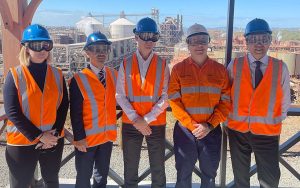Down Under ambitions: Australia’s journey to net zero – Darren Miller
If we want to become a renewable energy superpower, ARENA CEO Darren Miller says progress in the industrial sector will be critical.

This is an edited copy of Darren Miller’s keynote speech in the opening plenary at All Energy Australia on Wednesday 25th October 2023.
Among many items of bad news recently, I’m afraid there has also been bad news on the climate front: last month was the hottest September in modern recorded history and the largest monthly temperature anomaly by a wide margin.
Many in this room are here because of your concern for the climate, and these new facts further emphasise the importance of our work in reducing our reliance on fossil fuels and working diligently to achieve our emissions reduction targets.
We know that we are making progress in the electricity system with new renewable penetration records being broken constantly. At times renewable energy makes up over 70 per cent of generation in the National Electricity Market.
Our world-leading obsession with rooftop solar continues and we’re also seeing encouraging take-up of electric vehicles, which now represent over 8 per cent of new light vehicle sales.
However, things are going more slowly in the heavy transport and industrial sectors where renewable energy solutions are not yet cost competitive with fossil fuels.
Progress in the industrial sector in particular, which accounts for around 30 per cent of our emissions, is critical to achieve our emissions reduction goals and set us up as a renewable energy superpower.
What are the benefits of decarbonisation?

If industry can get on track with its decarbonisation opportunities, then it can:
- Play its part in helping reduce our domestic emissions by 43 per cent by 2030 and to net zero by 2050.
- Help to maintain jobs and economic activity in our regions.
- And set Australia up to capitalise on the world’s shift to green products like green aluminium, green ammonia, hydrogen and critical minerals and metals.
While electrification of our homes and vehicles are critical parts of the energy transition, we need to consider how all of these new clean technologies are made. Solar panels, electric cars and batteries require a host of exotic materials. All of these things come from the industrial sector – from mining, refining, manufacturing and transportation.
The reality is, none of our new clean technologies are truly green unless the whole upstream supply chain is also green.
Many people working in heavy industry today would prefer cheaper coal, gas and petroleum products, and for their operations to otherwise remain largely unchanged. After all, change is hard and costly.
And so, we in the renewables industry need to work closely with people in industry, because the world is changing rapidly and highly carbon-intensive businesses have no long-term future unless they make the change to renewables.
The importance of Industry

What do we mean when we talk about the industrial sector?
From an emissions perspective, our largest industrial emitters are in the mining industry – particularly CO2 and fugitive methane emissions from mining, processing and transporting coal and gas.
There are also significant emissions from the extraction and transport of iron ore, our largest single export commodity. Australia is the world’s largest producer and exporter of iron ore, responsible for around 40 per cent of the world’s production. We are a relatively small steel manufacturer though with only 0.3 per cent of the world’s steel production, yet our steel industry still emits around 10 million tonnes of CO2 annually.
Australia has six alumina refineries – these are facilities that process bauxite into alumina – the product that then goes into making aluminium. Total emissions from our six alumina refineries are over 13 million tonnes. That is two million tonnes more than all the natural gas burned in our homes for heating and cooking.
Beyond these very large emitters our industrial sector includes a large number of smaller emitters from sectors like food and beverage, pulp and paper, waste treatment, ammonia and chemicals, cement and lime, and general manufacturing.
Identifying and solving challenges to industrial emissions
When we look at industrial emissions, we can break the problem down into a few common categories:
- Industrial facilities are large electricity users. The aluminium smelter in Tomago in NSW accounts for around 10 per cent of the electricity consumed in that state. We already know that the grid is transitioning to renewable energy. Industry can help accelerate this shift by agreeing to purchase renewable electricity from retailers or by signing up to PPAs with renewable energy developers, bringing to market new wind and solar generation, firmed with large-scale batteries.
- Industrial facilities burn large amounts of coal and gas to produce heat for use in their processes.
Fortunately, renewable options exist to remove fossil fuels entirely and provide the heat required from renewable electricity, from biomass, from concentrated solar thermal, or from a renewable fuel like hydrogen.
ARENA’s role in the sector now and in the future
ARENA has prioritised helping the alumina industry for a number of years now. We recognised the large emissions profile associated with the alumina process and we’ve been working with the industry to evaluate and trial various options to help this industry make the shift to renewable energy.
- In 2021 we announced an $11 million grant to help Alcoa demonstrate mechanical vapour recompression technology that can help in the production of steam for the digestion phase.
- We followed this up in 2022 with another project to help Alcoa study and then trial electric calcination at another refinery in Western Australia.
- And earlier this year we announced a $32 million grant to Rio Tinto and Sumitomo to trial hydrogen calcination technology at the Yarwun Alumina Refinery in Gladstone.
- In the May Budget, the Government announced ARENA as the delivery agency for the Industrial Transformation Stream of the Powering the Regions fund. This $400 million fund will support regional industrial emitters to bring on new renewable energy options and energy efficiency initiatives to accelerate their decarbonisation plans.
- Importantly, this funding is not just available to the largest emitters but will also be available to smaller regional facilities that meet the eligibility criteria set out in the soon to be released guidelines.
If we don’t act quickly to address industrial emissions, we risk not achieving our climate targets. If we take this opportunity to act, we can set our industries up for success on the path to net zero.
The strengthening of the Safeguard Mechanism and increased global action on climate change is going to see increased activity in the industrial sector and this will create opportunities for many people here today.
We can all get involved in this by thinking about how our technology and our work could help solve the industrial emissions problem.
Many renewable solutions already exist and ARENA is ready and able to help you and industry on the journey.
LIKE THIS STORY? SIGN UP TO OUR NEWSLETTER

ARENA